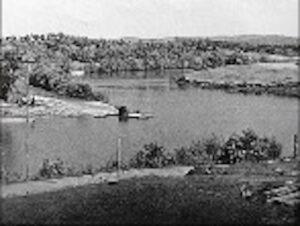Our focus in earlier articles has been, and remains, on the restoration of this once vibrant commercial and communal center. The city’s planned approach is to upgrade the streetscape, build a new fire hall, enforce building codes on derelict buildings, and add tax incentives to rehab and repurpose historic structures to once again serve surrounding neighborhoods. Along the way, we have briefly examined Burlington’s and the city’s early history, as rural Knoxville grew from a small pioneer outpost into a regional manufacturing and business center.
Let’s look a bit further into Burlington’s past.
The Ferries: In the age before cars, trucks, highways and bridges, you, your farm animals and produce got to Knoxville by wagon and horseback. From the east, you came up against the Holston and French Broad rivers. Privately operated ferries helped you across. Pulled by horse along cross-river cables, or pushed by long poles and sometimes rowed with oars, you got across through high water, wind and current.
The McBee ferry (1792) was located upstream on the Holston, and further downstream one used the Armstrong ferry (probably 1820s, near what became Asheville Highway), or downstream: the Boyd and Brabson ferries, located near where the French Broad River joined the Holston, at the headwaters of the Tennessee. Tony Holmes, a TVA reporter/historian, writes there have been some 23 ferries in and around Knoxville — with the heyday being from 1800 to 1920s. Better roads and cross river bridges eventually brought that era to a close.
The Armstrong Ferry: Irish born Robert Armstrong II (along with his dad Robert I) immigrated to America and, during the revolution, fought the British in the Carolinas in the 1780s. They received land grants in East Tennessee as a reward. Robert II’s sons, Moses and Aaron Armstrong, started and ran the ferry (1820s, long term it was Moses) that led travelers to “downtown” Burlington from banks of the Holston River, crossing near the site of the current Asheville Highway bridge from the Armstrong farm to what we now call Holston Drive (then it was Armstrong Ferry Pike).
See photos of the historic Armstrong house, ferry and likely crossing point (looking east).
The above photo of the Armstrong Ferry is weathered. A photo of the nearby Boyd’s Ferry, and its river setting, gives a much clearer view of the typical joined-timbered floating ferry structures. They were sturdy enough to carry people, wagons, horses, livestock and produce across the water so travelers could continue their journey.
 Burlington: Once across the Holston, you were on Armstrong Ferry Pike, heading west toward Knoxville. Burlington was the first stop, a few short miles after the river crossing. There you would find the famed Cal Johnson’s race track, a place to shop or sell your wares, or perhaps visit Chilhowee Park, rest or board the Burlington trolley on to the big city. These influences helped Burlington and surrounding residential neighborhoods grow.
Burlington: Once across the Holston, you were on Armstrong Ferry Pike, heading west toward Knoxville. Burlington was the first stop, a few short miles after the river crossing. There you would find the famed Cal Johnson’s race track, a place to shop or sell your wares, or perhaps visit Chilhowee Park, rest or board the Burlington trolley on to the big city. These influences helped Burlington and surrounding residential neighborhoods grow.
Greater Knoxville: The big city offered produce markets, retail shopping, dining and entertainment. Growing post-Civil War Knoxville (especially after the 1917 annexations) featured industry and employment opportunities: in the woolen mills, iron works, wood furniture and forestry trades, building construction, and railroad work, among other things away from farming in the countryside.
Neighborhoods like Burlington, grew along with the burgeoning city. Such pocket commercial centers, steeped in their colorful history and architecture, deserve a second chance. Let the renaissance begin …
Nick Della Volpe is a lawyer, a gardener and a former member of Knoxville City Council.





I have been keeping a history for 75+ years on the Armstrong Family, The settlements and history of the srmstrongs.
I live on part of the original land grant. Would love to share my documents and copy any other photos of the family and settlements.
That would be wonderful. Thank you.
It would nice understand the bigger picture as we look at the history of Burlington. You can reach me through Facebook , if my email does not come thru here. Ndellavolpe@bellsouth.net
Hi Nick – awesome stories! I believe some of the Armstrongs (descendants) still live in the area and own Armstrong Island in the Holston River near the ferry landing here in East Knox. Love how all of the history begins to piece itself together.
I was getting ready to guess 3 miles….we used to walk down there to fish, seems to me there was a little creek that entered the river where we fished, we could see the bridge, water wasn’t very deep along there.
The Asheville hwy bridge was built in 1931.
Addendum: someone asked how far “a few short miles” the Burlington center is from the western bank of the Armstrong ferry landing? On modern roads, which approximate the original Armstrong ferry pike — it is 2.7 miles.